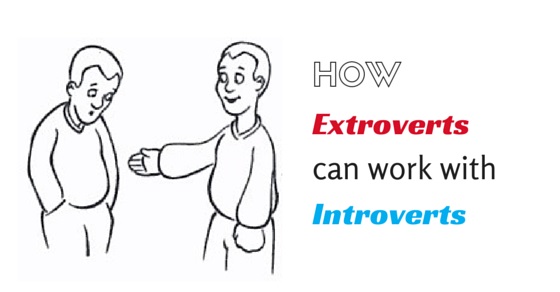There are two phrases “Yin-Yang” in Chinese Mythology and “Opposite Poles attract” in science.
Scientifically and philosophically these phrases mean that two contrary perspectives can complement each other and can work together by aiding each other.
The ability to interrelate and interconnect with each other is high when people of opposite personality team up at the workplace.
Each one can exploit their strengths cumulatively and achieve the targets at ease. Listed below are the tips that will help extroverts and introverts to work together as a single unit and achieve laurels.
 Human personality has been divided into 16 different types. But at the place of work, every human resource is either classified as an extrovert or an introvert.
Human personality has been divided into 16 different types. But at the place of work, every human resource is either classified as an extrovert or an introvert.
Every workplace has a team of human resource experts who identify the personality traits of their employees and assign them to different projects where in they can work efficiently.
But, apart from the management, it is equally important both for the extroverts and the introverts to understand the nature and temperament of each other to continue with a highly fruitful and productive journey together in a workplace.
Characteristic Traits of Extroverts and Introverts:
As per Michael Robinson PhD professor in psychology “Everything that people do is a reflection of their personality“
Before moving to the characteristics of introverts and extroverts let us first define them
Who is an introvert?
An introvert is rather quiet, silent, and less social and does not display much energy while at work and likes to be in solitude.
Common traits of introverts:
- Very reserved
- Enjoys solitude or isolation
- Completely focused
- Work on specific interests
- Comfortable in independent environments
- Prefers working in silence
- Works well when alone
- Think well before they speak
- Gives more importance to closed one on one relationship
- Avoid being center of attention
Who is an extrovert?
An extrovert is always chirpy, bubbling with energy, who adapts to any environment easily and is a great team player.
Common traits of extroverts:
- Enjoys working in a team
- Prefers open work settings
- Enthusiastic in nature
- Maintains positive attitude
- Outgoing
- Turns energetic when people are around
- Quick decision making
- Thinks out of the box
- Enjoys being center of attention
- Good at maintaining social networks
Difference Between Introverts and Extroverts:
An extrovert can handle their nervousness very well while an introvert cannot. Both extroverts and introverts could be extremely intelligent, diligent and can achieve any given target within the time limit.
The pinch point here is both have their own ways and means of doing the same. An extrovert derives energy by talking; interacting etc while an introvert derives his energy from being alone or with minimal friends.
| S.no | Introverts | Extroverts |
| 1 | Enjoys spending time alone | Enjoys socializing |
| 2 | Assess well and then take decisons | Quick decisions makers |
| 3 | Listen more | Speak more |
| 4 | Prefers one on one converstion | Loves to be centre of attention |
| 5 | Sociable with people who they know well | Good communicators |
| 6 | Good observers | Companionable and expressive |
| 7 | Think before taking any action | Taking actions practically |
| 8 | Self aware | Easily distracted |
| 9 | Introspective | Outgoing |
13 Peaceful Ways Extroverts Can Work with Introverts:
1. Learn each other:
An office comprises of people of different personal and social behavior. Hence the golden rule at office to co-exist with a person of opposite personality is to learn the positive and negative aspects about the person with whom we are going to work along.
When we meet and greet any colleague, their body language, eye contact, communication skills will help us to learn their basic behavioral traits.
This analysis helps the extrovert-introvert pair to relate to each other and work conveniently as a team.
2. Setting boundaries:
It is widely said that the extrovert can make an introvert work for him. With superfluous energy display, the extrovert can become the center of attention at office.
Any office management will always prefer to have an extrovert manager who can represent his team in global presence.
However, introverts who speak very little if become managers who need to handle a bunch of extroverts in their team, they find it little taxing.
It is very well appreciated practice to set up boundary conditions where in both parties discuss together what activity they are best at and share work accordingly.
For example, the introvert can complete data analysis while the extrovert can present it effectively among audience thereby earning a good name and repute for both of them.
3. Establish communication channel:
Communication between team members should be very efficient at a workplace. While an extrovert can talk nonstop and are super expressive, the introverts are naïve, reluctant and closed to themselves.
When an extrovert uses mincing words to convince the client, the introvert will state statistics, remain assertive and talk only when needed.
The extroverts do not think before speaking or acting while the introverts take plenty of time to think and act.
The ideal way is to make the extroverts can take the first step towards creating a conducive atmosphere for the introvert to settle down first.
Accompanying each other during coffee or lunch break will help both of them to loosen up and start communicating.
4. Rapport building:
A good team is the one that has the ability to stand as one unit and perform tirelessly. For extroverts to work with introverts incessantly, they need to build a rapport first and in this exercise they excel.
Extroverts can bring people together and establish a bond between them. On the other hand, introverts prefer to be alone and content with themselves.
But astonishingly they love the company of bubbly people who can keep the atmosphere lively.
Once the initial reluctance is overcome and the introvert finds a true comrade his extrovert friend, the ship starts to sail smooth. The push and pull between the extrovert- introvert pair is interesting to watch as one is spontaneous and the other is calculative.
5. Maintain professional attitude:
At times, despite all efforts the extroverts find it hard to get the introverts mingle with the rest of the crew.
There could be adaptability situations, social background or a sheer lack of will to participate from the side of introverts. In such cases, the best practice is to maintain professional attitude with each other.
Instead of pondering on why the person is unable to express feelings or why the person is in solitude, it is a good habit to assign work, ask for updates , give feedback for completed tasks and keep the wheel moving.
This behavior at work comforts the introverts and helps them to deliver their maximum potential. Once they feel comfortable with their surroundings, they might loosen up and become friends with each other.
6. Adapt to each other’s style of work:
The biggest challenge at the workplace for an introvert is to adjust and adapt to the style of work.
The introverts are skeptical about sudden changes and they require time to think and reflect on decisions. With extroverts around, the introverts do not get their peaceful style of working.
If an introvert prefers quiet workplace the extrovert is there to make it noisy and chatter filled. If an introvert pays attention to fine detailing, the extrovert rather believes in presentation and stealing the show.
To maximize productivity from an introvert, it is a good idea to assign them individual portions of the project where inter-dependency is less.
Since, adaptability comes as a natural virtue for an extrovert, he is the one who makes the first move to adapt his work culture to suit the other party.
7. Win-Win situation:
During a crisis situation at workplace, both introverts and extroverts have different approaches for problem solving.
The extrovert is always the first to initiate such discussion meetings. In spite of having good understanding and expertise in problem solving, the introverts may not be ready to jump for rescue.
In such situation, taking the upper hand the extrovert must act as catalyst and propel the introvert into action. The introverts are by nature stubborn and precise while communicating their thoughts.
They may find it hard to please clients with their factual presentation. In such circumstances, by mediating the meeting with their sweet antics, the extrovert can achieve win-win situation.
8. Acknowledge and adulate:
Extroverts are attention seekers. They have a gift of gab with which they are always in the good books of the management.
When extroverts need to work with introverts, the first step they should initiate sessions where the effort and hard work of the introverts are appreciated in a public forum. To combat loneliness, introverts are mostly hard workers.
When their hard work and dedication is adulated in a public forum, the introverts look forward to meet their peers and start to enjoy their work time.
9. Less talk more work:
Though extroverts are highly loved by others because of their talkative and expressive nature, the most irritating habit of an extrovert that irks an introvert is his nonstop talking.
The introverts are good when it comes to casual chatting but they cannot indulge in continuous chit chats.
Hence to get introverts to get working, the first thing that extroverts can do is to stop the unnecessary over the counter discussions. Regular status meetings and team discussions should be encouraged where the introverts can actively participate
10. Work in a small group:
Working in a small group helps the introverts a lot. They find it easy to communicate with less number of people and hence deliver more.
So if an extrovert needs to work with introverts, he has to break the team into smaller subsections and get his work done. This avoids unnecessary arguments, verbal clashes between colleagues and establishes a healthier work culture.
11 Don’t get personal:
Introverts are highly emotionally sensitive. They are too opinionated and judgmental. Hence, to befriend an introvert and get the work delivered timely, the extrovert must be cautious not to hurt their sentiments or get personal about them.
For an introvert, an impression formed about someone remains unchanged for years together. Hence the extrovert, to get working in unison with introverts needs to draw a line while he speaks and acts.
In the process initially there will definitely be heated arguments and non-conformance issues but over time hard feelings will wade away.
12. Companionship and Trust:
Introverts have few friends but their friendship is deep rooted. The companionship and trust they share with their closed ones is superlative.
For an extrovert to work with an introvert, the first and foremost task will be to gain their trust. With trust grows companionship.
The extrovert must be aware of the likes and dislikes of his complimentary and sculpt his actions in the most desirable way. There are introverts who are in the border and they may be less secretive and more social.
Hence the degree of seclusion that the introvert expects initially must be conferred upon him to gain his trust. Once the introvert starts to trust his partner, his outlook towards the extrovert will change and the team flourishes.
13. Loosen out and have fun:
Official parties, team lunch or dinners are best ways to socialize with each other and spend some quality time. While an extrovert jumps into his party mood the moment such an event is organized, the introvert finds excuse to run away from the crowd.
The more introverts are cajoled into attending such events, easy it is for them to find a good aide and friend. And once they get emotionally involved with the team, the introverts remain no more alienated to the team and team members.
Hence the extroverts must act as motivators to get the introverts loosen up and have fun.
To Wrap Up:
There are examples of many introverts who have quit their lucrative jobs as they are asked to shed their shell and mingle with everyone.
The extrovert is verbally loud and vibrant while the introvert has clarity and vision but cannot express it to the outside world. A combination of these two powers can turn any difficult task into an easy one.
When one can volunteer and unleash their energy levels, the other can be a silent monk and drive the whole process to culmination. Thus, practicing “live and let live” helps the extroverts to work conveniently with introverts.











































